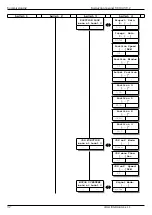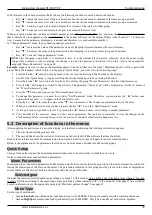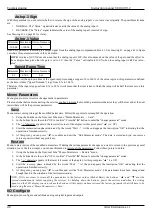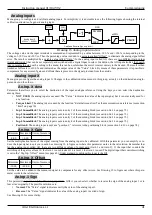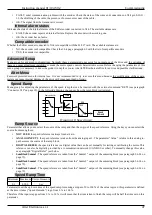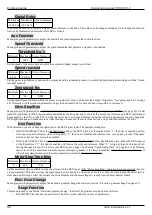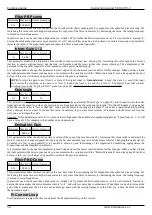
Instruction manual 91/104 V9.2
Commissioning
Analog inputs
Menu group to configure and calibrate analog inputs. For simplicity it is advisable to see the following figure showing the internal
calibration structure of a generic analog input.
The voltage value on the input terminals is measured and represented by a value between -100 % and +100 % corresponding to the
voltage of -10Vcc and +10Vcc. Then the percentage value is added to a set value called “Offset " to eliminate the analog signal offset
error. The result is multiplied by a setable value called “Gain "; In the analog input called AI1 there are two different Gain values
(Gain1 and Gain2) that can be set separately and switched with a digital input to select. In addition, the AI1 input also has the possib
-
ility to reverse the sign with a setting in the menu; this can be useful when the motor rotates contrary to the desired. The result is then
limited as full scale to ±100 % and indicated as the output value of the “Value " block. By means of these parameters it is possible to
compensate for any errors of gains and offsets that are present in the signal provided from the outside.
Analog input X
Menu group to configure the analog input X. Changes to the calibration values made in this group, act only on the indicated analog in-
put and not on the others.
An.Inp. X dest
Parameter that allows you to select the destination of the input analogue reference. Using the keys you can select the destination
among these:
•
NOT USED
: the analog input is not used. The “Value " indicates the value of the input signal, but it is not actually used for
any function.
•
Torque Limit
: The analog input is used by the function "External torque limit" as the maximum torque reference (see section
•
Inp.1 SummBlock
: The analog input is sent to entry 1 of the summing block (see section 5.6.14 on page 75).
•
Inp.2 SummBlock
: The analog input is sent to entry 2 of the summing block (see section 5.6.14 on page 75).
•
Inp.3 SummBlock
: The analog input is sent to entry 3 of the summing block (see section 5.6.14 on page 75).
•
Inp.4 SummBlock
: The analog input is sent to entry 4 of the summing block (see section 5.6.14 on page 75).
•
Position 0:
The analog input is sent as a “position 0 " reference to the positioning block (see section 5.6.13 on page 74).
An.Inp. X Gain
Minimum Maximum Units of measure
-2.00
+2.00
-
Set the multiplication factor of the signal coming from the analog input to be calibrated. With this parameter you can amplify or re-
duce the input signal to suit your needs. See drawing 15 to figure out where this parameter works in the calculation. Remember that
for the analog input called AI1 there are two different values of preset gain (Gain 1 and Gain 2); If the input that controls the
switching of the gain is at level 0, the Gain 1 is used instead if it is level 1 the Gain 2 is used. The digital input that controls switching
is set in the "Dig.Inp. X Dest“ menu (see page 43); Under standard conditions this input is the DI3.
An.Inp. X Offset
Minimum Maximum Units of measure
-10.00
+10.00
%
Set the value to be added to the measured signal to compensate for any offset errors. See Drawing 15 to figure out where this para-
meter works in the calculation.
An.Inp.1 Sign
This parameter is present only for the analog input AI1. With it you can select whether to reverse the sign of the analog input 1 or to
leave it as originally. The possible selections are:
•
Normal
: The “Value " signal indicates exactly the value of the analog input 1.
•
Reverse
: The “Value " signal indicates the value of the analog input 1 inverted of sign.
See Drawing 15 for more clarity.
Alter Elettronica s.r.l.
41
Drawing 15 Analog input structure
Analog Input X
±10Vcc → ±100%
+
OFFSET
X
VALUE
GAIN1/
GAIN2
±100%
Gain2 and Reverse Sign only for AI1
REVERSE
NORM
SIGN
-1






